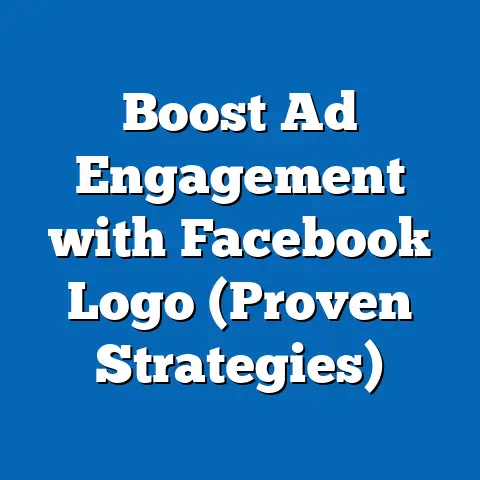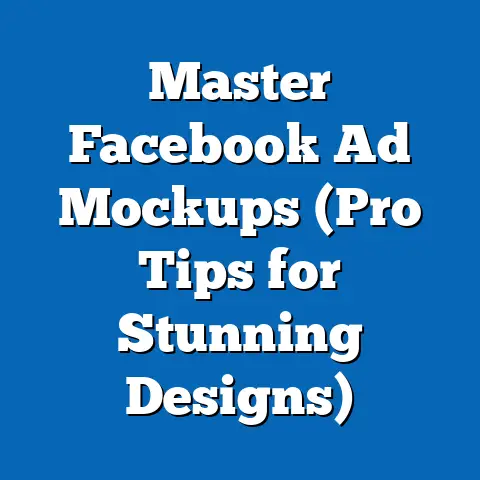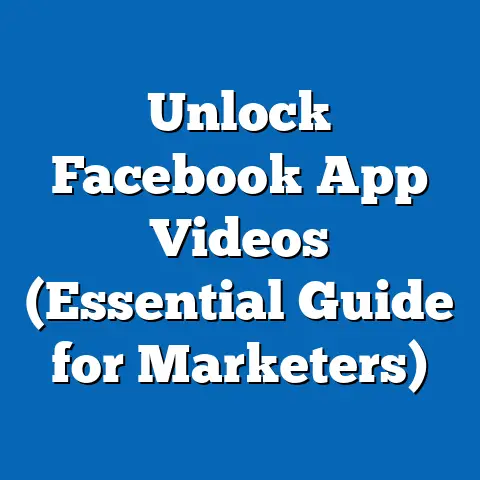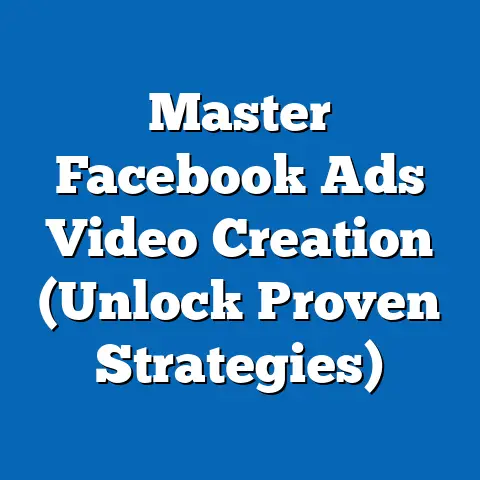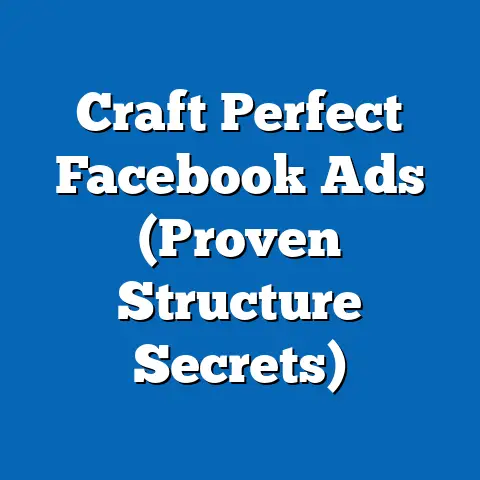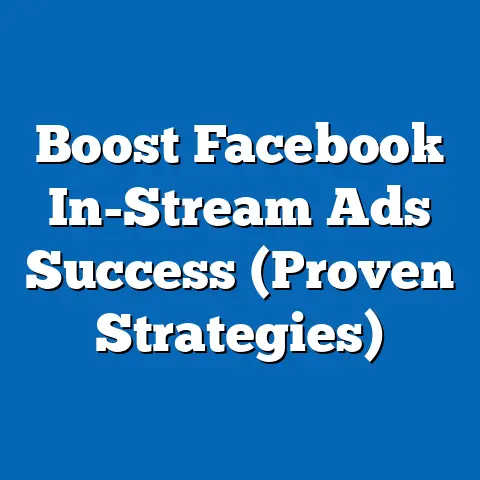Boost ROI with Effective Facebook Ads (Proven Strategies)
Boost ROI with Effective Facebook Ads: Proven Strategies for Long-Term Savings
In today’s digital age, if you’re not advertising, you’re likely invisible. And if you’re not advertising effectively, you’re essentially throwing money into the digital abyss. Facebook, with its billions of users, remains a powerhouse for businesses looking to connect with their target audience. But simply setting up an ad and hoping for the best isn’t going to cut it. We need to talk about Return on Investment (ROI) – the holy grail of any advertising campaign.
ROI, in essence, is the measure of the profit you make from every dollar you spend on advertising. A positive ROI means you’re making money; a negative ROI means you’re losing it. And let’s be honest, nobody wants to lose money.
The beauty of Facebook advertising lies in its granular targeting capabilities. We’re talking about reaching incredibly specific demographics, interests, and behaviors. This means we can show our ads to the right people, increasing the chances of engagement and conversion. Think about it: wouldn’t you rather show your ad for organic dog treats to dog owners in your local area than to a random group of people who might not even own pets?
Effective advertising strategies aren’t just about short-term gains. They’re about building a sustainable system that reduces your cost of customer acquisition (CAC) and increases your profit margins over time. By consistently optimizing your campaigns, refining your targeting, and creating compelling ad creatives, you can create a flywheel effect that drives long-term growth.
My journey with Facebook Ads started with a lot of trial and error. I remember one of my first campaigns for a local bakery. I thought I had a killer ad – a mouthwatering photo of a chocolate cake with a simple “Order Now!” button. I targeted everyone within a 10-mile radius. The result? A few clicks, zero sales, and a serious dent in my marketing budget. It was a painful lesson, but it taught me the importance of understanding your audience, crafting targeted messaging, and tracking your results.
This guide is designed to help you avoid those costly mistakes and equip you with the knowledge and strategies you need to achieve a positive and sustainable ROI with your Facebook Ads. We’ll dive into everything from understanding the Facebook Ads ecosystem to crafting the perfect ad, targeting your audience effectively, managing your budget, and analyzing your campaign performance.
So, let’s get started on the path to transforming your Facebook Ads from a cost center into a profit-generating machine!
Section 1: Understanding Facebook Ads
Before we dive into the nitty-gritty of ROI optimization, it’s crucial to have a solid understanding of the Facebook Ads landscape. It’s a complex ecosystem, but once you grasp the fundamentals, you’ll be well-equipped to navigate it effectively.
Different Ad Formats: A Visual Feast
Facebook offers a variety of ad formats, each designed to capture attention and drive engagement in different ways. Choosing the right format for your campaign is crucial for maximizing its impact.
-
Image Ads: These are the simplest and most common ad format. They consist of a single image, a headline, ad copy, and a call-to-action button. Image ads are great for showcasing products, highlighting key benefits, or driving traffic to your website.
-
Video Ads: Video ads are incredibly engaging and can be used to tell a story, demonstrate a product, or share a customer testimonial. They can be short and sweet or longer and more in-depth, depending on your message and target audience. I’ve personally seen video ads generate significantly higher engagement and conversion rates than image ads, especially when they’re well-produced and emotionally resonant.
-
Carousel Ads: Carousel ads allow you to showcase multiple images or videos in a single ad unit. Each image or video has its own headline, description, and link, making them ideal for showcasing a range of products, highlighting different features of a single product, or telling a sequential story.
-
Collection Ads: These ads are designed for e-commerce businesses and allow users to browse and purchase products directly from the ad. They typically feature a cover image or video and a selection of related products.
-
Instant Experience Ads: Formerly known as Canvas Ads, Instant Experience Ads provide a full-screen, mobile-optimized experience that loads instantly when someone clicks on your ad. They can include images, videos, carousels, and even interactive elements, making them a powerful tool for storytelling and driving engagement.
-
Lead Ads: Lead ads are designed to collect contact information from potential customers directly within Facebook. They feature a pre-filled form that users can submit with just a few taps, making them a convenient way to generate leads for your business.
-
Stories Ads: These are full-screen ads that appear between users’ Stories on Facebook and Instagram. They’re a great way to reach a younger audience and capture their attention with visually appealing content.
Image Ads: These are the simplest and most common ad format. They consist of a single image, a headline, ad copy, and a call-to-action button. Image ads are great for showcasing products, highlighting key benefits, or driving traffic to your website.
Video Ads: Video ads are incredibly engaging and can be used to tell a story, demonstrate a product, or share a customer testimonial. They can be short and sweet or longer and more in-depth, depending on your message and target audience. I’ve personally seen video ads generate significantly higher engagement and conversion rates than image ads, especially when they’re well-produced and emotionally resonant.
Carousel Ads: Carousel ads allow you to showcase multiple images or videos in a single ad unit. Each image or video has its own headline, description, and link, making them ideal for showcasing a range of products, highlighting different features of a single product, or telling a sequential story.
Collection Ads: These ads are designed for e-commerce businesses and allow users to browse and purchase products directly from the ad. They typically feature a cover image or video and a selection of related products.
Instant Experience Ads: Formerly known as Canvas Ads, Instant Experience Ads provide a full-screen, mobile-optimized experience that loads instantly when someone clicks on your ad. They can include images, videos, carousels, and even interactive elements, making them a powerful tool for storytelling and driving engagement.
Lead Ads: Lead ads are designed to collect contact information from potential customers directly within Facebook. They feature a pre-filled form that users can submit with just a few taps, making them a convenient way to generate leads for your business.
Stories Ads: These are full-screen ads that appear between users’ Stories on Facebook and Instagram. They’re a great way to reach a younger audience and capture their attention with visually appealing content.
The Facebook Advertising Ecosystem: A Connected Web
Understanding the different components of the Facebook advertising ecosystem is essential for managing your campaigns effectively.
-
Ads Manager: This is your central hub for creating, managing, and tracking your Facebook ad campaigns. It’s where you’ll set your budget, define your target audience, create your ads, and analyze your results.
-
Audience Insights: This tool provides valuable data about your target audience, including their demographics, interests, behaviors, and purchase habits. It can help you refine your targeting and create more relevant and engaging ads.
-
Facebook Pixel: The Facebook Pixel is a small piece of code that you install on your website. It tracks user behavior, such as page views, purchases, and lead form submissions, and sends that data back to Facebook. This data can be used to optimize your ad campaigns, track conversions, and create retargeting audiences. This is the linchpin to effective attribution and campaign optimization. Without it, you’re flying blind.
-
Business Manager: If you’re managing multiple Facebook pages or ad accounts, Business Manager is your go-to tool. It allows you to centralize your assets and manage permissions for your team.
Ads Manager: This is your central hub for creating, managing, and tracking your Facebook ad campaigns. It’s where you’ll set your budget, define your target audience, create your ads, and analyze your results.
Audience Insights: This tool provides valuable data about your target audience, including their demographics, interests, behaviors, and purchase habits. It can help you refine your targeting and create more relevant and engaging ads.
Facebook Pixel: The Facebook Pixel is a small piece of code that you install on your website. It tracks user behavior, such as page views, purchases, and lead form submissions, and sends that data back to Facebook. This data can be used to optimize your ad campaigns, track conversions, and create retargeting audiences. This is the linchpin to effective attribution and campaign optimization. Without it, you’re flying blind.
Business Manager: If you’re managing multiple Facebook pages or ad accounts, Business Manager is your go-to tool. It allows you to centralize your assets and manage permissions for your team.
Data Analytics: The Key to Optimization
Data analytics is the cornerstone of effective Facebook advertising. By tracking and analyzing your campaign performance, you can identify what’s working, what’s not, and make data-driven decisions to optimize your campaigns for better ROI. We’ll delve deeper into specific metrics and optimization strategies later in this guide.
Key Takeaway: Understanding the different ad formats, the Facebook advertising ecosystem, and the importance of data analytics is crucial for setting the stage for successful and ROI-driven campaigns.
Next Step: Familiarize yourself with the Ads Manager interface and explore the different ad formats available. Install the Facebook Pixel on your website and start tracking user behavior.
Section 2: Crafting the Perfect Ad
Now that we have a grasp on the Facebook Ads ecosystem, let’s talk about the heart of your campaign: the ad itself. A well-crafted ad can capture attention, resonate with your target audience, and drive conversions. A poorly crafted ad will be ignored, wasted spend, and a missed opportunity.
The Components of a High-Performing Ad
A high-performing Facebook ad consists of three key components:
-
Compelling Visuals: The image or video is the first thing people see, so it needs to be eye-catching and relevant to your target audience. Use high-quality images or videos that showcase your product or service in the best possible light.
-
Engaging Copy: Your ad copy should be clear, concise, and persuasive. Highlight the benefits of your product or service and address the needs and pain points of your target audience. Avoid jargon and focus on creating a connection with your audience.
-
Strong Call-to-Action (CTA): Your CTA should tell people exactly what you want them to do, whether it’s visiting your website, making a purchase, or signing up for a newsletter. Use action-oriented language and make your CTA button prominent and easy to click.
Compelling Visuals: The image or video is the first thing people see, so it needs to be eye-catching and relevant to your target audience. Use high-quality images or videos that showcase your product or service in the best possible light.
Engaging Copy: Your ad copy should be clear, concise, and persuasive. Highlight the benefits of your product or service and address the needs and pain points of your target audience. Avoid jargon and focus on creating a connection with your audience.
Strong Call-to-Action (CTA): Your CTA should tell people exactly what you want them to do, whether it’s visiting your website, making a purchase, or signing up for a newsletter. Use action-oriented language and make your CTA button prominent and easy to click.
Proven Strategies for Creating Resonant Ads
Here are some proven strategies for creating ads that resonate with your target audience:
-
Storytelling: People love stories. Use your ad copy to tell a story that connects with your audience on an emotional level. Share a customer success story, explain the origin of your product, or highlight the values that drive your business.
-
User-Generated Content (UGC): UGC is content created by your customers, such as reviews, testimonials, and photos or videos of them using your product. UGC is incredibly powerful because it’s authentic and trustworthy. Feature UGC in your ads to build credibility and social proof. I’ve seen campaigns featuring authentic customer reviews outperform professionally produced ads by a significant margin.
-
Social Proof: Humans are social creatures, and we’re more likely to do something if we see that other people are doing it too. Highlight your customer reviews, testimonials, and social media following in your ads to build trust and encourage conversions.
-
Problem/Solution: Identify a common problem that your target audience faces and position your product or service as the solution. This approach can be incredibly effective for capturing attention and driving engagement.
-
Urgency and Scarcity: Creating a sense of urgency or scarcity can encourage people to take action. Use phrases like “Limited Time Offer,” “While Supplies Last,” or “Don’t Miss Out!” to create a sense of FOMO (Fear of Missing Out).
Storytelling: People love stories. Use your ad copy to tell a story that connects with your audience on an emotional level. Share a customer success story, explain the origin of your product, or highlight the values that drive your business.
User-Generated Content (UGC): UGC is content created by your customers, such as reviews, testimonials, and photos or videos of them using your product. UGC is incredibly powerful because it’s authentic and trustworthy. Feature UGC in your ads to build credibility and social proof. I’ve seen campaigns featuring authentic customer reviews outperform professionally produced ads by a significant margin.
Social Proof: Humans are social creatures, and we’re more likely to do something if we see that other people are doing it too. Highlight your customer reviews, testimonials, and social media following in your ads to build trust and encourage conversions.
Problem/Solution: Identify a common problem that your target audience faces and position your product or service as the solution. This approach can be incredibly effective for capturing attention and driving engagement.
Urgency and Scarcity: Creating a sense of urgency or scarcity can encourage people to take action. Use phrases like “Limited Time Offer,” “While Supplies Last,” or “Don’t Miss Out!” to create a sense of FOMO (Fear of Missing Out).
A/B Testing: The Key to Continuous Improvement
A/B testing involves creating two or more versions of your ad with slight variations and testing them against each other to see which performs best. By A/B testing different elements of your ad, such as the headline, image, ad copy, and CTA, you can refine your messaging and visuals based on audience response and continuously improve your ad performance.
I always recommend starting with A/B testing the visual element of your ad, as this is often the first thing people see. Then, test different headlines and ad copy to see which resonates best with your target audience. Finally, test different CTAs to see which drives the most conversions.
Key Takeaway: Crafting the perfect ad involves combining compelling visuals, engaging copy, and a strong CTA. By leveraging storytelling, UGC, social proof, and A/B testing, you can create ads that resonate with your target audience and drive conversions.
Next Step: Brainstorm different ad concepts based on the strategies outlined above. Create multiple versions of your ad with slight variations and use A/B testing to refine your messaging and visuals.
Section 3: Targeting Your Audience Effectively
You can have the most beautiful ad in the world, but if it’s shown to the wrong people, it’s a waste of time and money. Facebook’s advanced targeting options are what set it apart from other advertising platforms. It allows us to laser-focus our ads on the people who are most likely to be interested in our products or services.
Facebook’s Advanced Targeting Options
Facebook offers a wide range of targeting options, including:
-
Demographic Targeting: Target people based on their age, gender, location, education, relationship status, and other demographic information.
-
Interest-Based Targeting: Target people based on their interests, hobbies, and activities. Facebook gathers this information from the pages people like, the groups they join, and the content they engage with.
-
Behavioral Targeting: Target people based on their purchase behavior, device usage, travel habits, and other behavioral data. Facebook gathers this information from users’ online activity, both on and off Facebook.
-
Custom Audiences: Custom Audiences allow you to target people who have already interacted with your business, such as website visitors, email subscribers, or existing customers. You can upload a list of email addresses or phone numbers, or create a custom audience based on website traffic or app activity.
-
Lookalike Audiences: Lookalike Audiences allow you to reach new people who are similar to your existing customers or website visitors. Facebook analyzes the characteristics of your source audience and finds other users who share similar traits.
Demographic Targeting: Target people based on their age, gender, location, education, relationship status, and other demographic information.
Interest-Based Targeting: Target people based on their interests, hobbies, and activities. Facebook gathers this information from the pages people like, the groups they join, and the content they engage with.
Behavioral Targeting: Target people based on their purchase behavior, device usage, travel habits, and other behavioral data. Facebook gathers this information from users’ online activity, both on and off Facebook.
Custom Audiences: Custom Audiences allow you to target people who have already interacted with your business, such as website visitors, email subscribers, or existing customers. You can upload a list of email addresses or phone numbers, or create a custom audience based on website traffic or app activity.
Lookalike Audiences: Lookalike Audiences allow you to reach new people who are similar to your existing customers or website visitors. Facebook analyzes the characteristics of your source audience and finds other users who share similar traits.
Creating Lookalike Audiences: Expanding Your Reach
Lookalike Audiences are one of the most powerful tools for expanding your reach and finding new potential customers. To create a Lookalike Audience, you need a source audience, which can be a Custom Audience, a Facebook page audience, or a conversion pixel.
Facebook will then analyze the characteristics of your source audience and find other users who share similar traits. You can choose the size of your Lookalike Audience, from 1% to 10% of the total population of your target country. A smaller percentage will result in a more targeted audience, while a larger percentage will result in a broader audience.
I typically recommend starting with a 1% or 2% Lookalike Audience and then gradually increasing the size as you scale your campaign.
Audience Segmentation: Tailoring Your Message
Audience segmentation involves dividing your target audience into smaller groups based on their demographics, interests, behaviors, or other characteristics. By segmenting your audience, you can tailor your messaging and create ads that are more relevant and engaging to each group.
For example, if you’re selling clothing, you might segment your audience by gender, age, and style preferences. You could then create different ads for each segment, featuring clothing that is most likely to appeal to them.
Key Takeaway: Effective targeting is crucial for maximizing your ROI. By leveraging Facebook’s advanced targeting options, creating Lookalike Audiences, and segmenting your audience, you can reach the right people with the right message at the right time.
Next Step: Define your ideal customer and identify their demographics, interests, and behaviors. Create Custom Audiences based on your existing customer data and website traffic. Create Lookalike Audiences to expand your reach and find new potential customers.
Section 4: Budgeting and Bidding Strategies
Now that you know how to create compelling ads and target the right audience, let’s talk about money. Setting a realistic budget and choosing the right bidding strategy are essential for maximizing your ROI and avoiding overspending.
Setting a Realistic Budget
Setting a realistic budget for your Facebook ad campaigns depends on several factors, including your business goals, target audience size, and expected ROI.
-
Define Your Business Goals: What do you want to achieve with your Facebook ad campaigns? Do you want to increase brand awareness, generate leads, or drive sales? Your business goals will help you determine how much you’re willing to spend on advertising.
-
Estimate Your Target Audience Size: The larger your target audience, the more you’ll need to spend to reach them. Use Facebook Audience Insights to estimate the size of your target audience.
-
Calculate Your Expected ROI: How much revenue do you expect to generate from your Facebook ad campaigns? Use historical data or industry benchmarks to estimate your expected ROI.
Define Your Business Goals: What do you want to achieve with your Facebook ad campaigns? Do you want to increase brand awareness, generate leads, or drive sales? Your business goals will help you determine how much you’re willing to spend on advertising.
Estimate Your Target Audience Size: The larger your target audience, the more you’ll need to spend to reach them. Use Facebook Audience Insights to estimate the size of your target audience.
Calculate Your Expected ROI: How much revenue do you expect to generate from your Facebook ad campaigns? Use historical data or industry benchmarks to estimate your expected ROI.
Once you have a good understanding of these factors, you can set a realistic budget that aligns with your business goals and expected ROI.
As a rule of thumb, I often advise clients to start with a smaller budget and gradually increase it as they see positive results. This allows you to test your campaigns, refine your targeting, and optimize your ads before committing to a larger investment.
Different Bidding Strategies
Facebook offers several different bidding strategies, each designed to optimize your campaigns for different goals.
-
Cost Per Click (CPC): With CPC bidding, you pay each time someone clicks on your ad. This is a good option if you’re focused on driving traffic to your website.
-
Cost Per Impression (CPM): With CPM bidding, you pay for every 1,000 impressions your ad receives. This is a good option if you’re focused on increasing brand awareness.
-
Cost Per Action (CPA): With CPA bidding, you pay only when someone takes a specific action, such as making a purchase or signing up for a newsletter. This is a good option if you’re focused on driving conversions.
-
Daily Unique Reach: This strategy aims to show your ad to as many unique people as possible each day.
-
Link Clicks: Optimizes for getting the most link clicks possible within your budget.
-
Landing Page Views: Similar to link clicks, but optimizes for users who actually load your landing page.
-
Impressions: Maximizes the number of times your ad is shown, focusing on reach.
Cost Per Click (CPC): With CPC bidding, you pay each time someone clicks on your ad. This is a good option if you’re focused on driving traffic to your website.
Cost Per Impression (CPM): With CPM bidding, you pay for every 1,000 impressions your ad receives. This is a good option if you’re focused on increasing brand awareness.
Cost Per Action (CPA): With CPA bidding, you pay only when someone takes a specific action, such as making a purchase or signing up for a newsletter. This is a good option if you’re focused on driving conversions.
Daily Unique Reach: This strategy aims to show your ad to as many unique people as possible each day.
Link Clicks: Optimizes for getting the most link clicks possible within your budget.
Landing Page Views: Similar to link clicks, but optimizes for users who actually load your landing page.
Impressions: Maximizes the number of times your ad is shown, focusing on reach.
The best bidding strategy for you will depend on your business goals and the type of action you want people to take.
Monitoring and Adjusting Your Budget
It’s crucial to monitor your budget and adjust it in real-time based on campaign performance. If you’re seeing positive results, you can increase your budget to scale your campaign and reach more people. If you’re not seeing the results you want, you can decrease your budget or pause your campaign to avoid overspending.
I recommend checking your campaign performance at least once a day and making adjustments as needed. Pay attention to your key performance indicators (KPIs), such as click-through rate (CTR), conversion rate, and return on ad spend (ROAS), to determine whether your campaign is on track.
Key Takeaway: Setting a realistic budget and choosing the right bidding strategy are essential for maximizing your ROI. By defining your business goals, estimating your target audience size, and calculating your expected ROI, you can set a budget that aligns with your objectives. Monitor your budget and adjust it in real-time based on campaign performance.
Next Step: Define your business goals and estimate your target audience size. Calculate your expected ROI and set a realistic budget for your Facebook ad campaigns. Choose the bidding strategy that is most appropriate for your goals.
Section 5: Analyzing and Optimizing Campaign Performance
You’ve created your ads, targeted your audience, and set your budget. Now comes the crucial part: analyzing your campaign performance and optimizing it for better ROI.
Key Performance Indicators (KPIs) to Track
Tracking the right KPIs is essential for understanding how your campaigns are performing and identifying areas for improvement.
-
Click-Through Rate (CTR): This is the percentage of people who see your ad and click on it. A high CTR indicates that your ad is relevant and engaging to your target audience.
-
Conversion Rate: This is the percentage of people who click on your ad and take a desired action, such as making a purchase or signing up for a newsletter. A high conversion rate indicates that your landing page is effective and your offer is compelling.
-
Cost Per Click (CPC): This is the average cost you pay each time someone clicks on your ad. A low CPC indicates that your ad is efficient and you’re not overpaying for clicks.
-
Cost Per Acquisition (CPA): This is the average cost you pay each time someone takes a desired action. A low CPA indicates that your campaign is efficient and you’re not overpaying for conversions.
-
Return on Ad Spend (ROAS): This is the revenue you generate for every dollar you spend on advertising. A high ROAS indicates that your campaign is profitable and you’re getting a good return on your investment.
Click-Through Rate (CTR): This is the percentage of people who see your ad and click on it. A high CTR indicates that your ad is relevant and engaging to your target audience.
Conversion Rate: This is the percentage of people who click on your ad and take a desired action, such as making a purchase or signing up for a newsletter. A high conversion rate indicates that your landing page is effective and your offer is compelling.
Cost Per Click (CPC): This is the average cost you pay each time someone clicks on your ad. A low CPC indicates that your ad is efficient and you’re not overpaying for clicks.
Cost Per Acquisition (CPA): This is the average cost you pay each time someone takes a desired action. A low CPA indicates that your campaign is efficient and you’re not overpaying for conversions.
Return on Ad Spend (ROAS): This is the revenue you generate for every dollar you spend on advertising. A high ROAS indicates that your campaign is profitable and you’re getting a good return on your investment.
Using Facebook Analytics and Other Tools
Facebook Analytics provides valuable data about your campaign performance, including demographics, interests, behaviors, and purchase habits of your target audience. You can use this data to refine your targeting, improve your ad creatives, and optimize your bidding strategy.
In addition to Facebook Analytics, there are several other tools that can help you analyze and optimize your campaign performance.
-
Google Analytics: This is a free web analytics tool that provides detailed information about your website traffic, including the source of your traffic, the pages people visit, and the actions they take.
-
Third-Party Tracking Tools: These tools offer advanced tracking and attribution capabilities, allowing you to see exactly which ads are driving conversions and which are not.
Google Analytics: This is a free web analytics tool that provides detailed information about your website traffic, including the source of your traffic, the pages people visit, and the actions they take.
Third-Party Tracking Tools: These tools offer advanced tracking and attribution capabilities, allowing you to see exactly which ads are driving conversions and which are not.
Actionable Strategies for Optimizing Campaigns
Based on your data analysis, you can implement several actionable strategies to optimize your campaigns for better ROI.
-
Pause Underperforming Ads: If you have ads that are not performing well, pause them to avoid wasting money.
-
Refine Your Targeting: If your ads are not reaching the right people, refine your targeting to narrow your audience and focus on those who are most likely to be interested in your products or services.
-
Improve Your Ad Creatives: If your ads are not engaging or converting, improve your ad creatives to make them more compelling and relevant to your target audience.
-
Adjust Your Bidding Strategy: If you’re overpaying for clicks or conversions, adjust your bidding strategy to lower your costs.
-
Scale Successful Campaigns: If you have campaigns that are performing well, scale them by increasing your budget and expanding your targeting.
Pause Underperforming Ads: If you have ads that are not performing well, pause them to avoid wasting money.
Refine Your Targeting: If your ads are not reaching the right people, refine your targeting to narrow your audience and focus on those who are most likely to be interested in your products or services.
Improve Your Ad Creatives: If your ads are not engaging or converting, improve your ad creatives to make them more compelling and relevant to your target audience.
Adjust Your Bidding Strategy: If you’re overpaying for clicks or conversions, adjust your bidding strategy to lower your costs.
Scale Successful Campaigns: If you have campaigns that are performing well, scale them by increasing your budget and expanding your targeting.
I’ve personally seen campaigns transform from losing money to generating a significant ROI simply by consistently analyzing the data and making data-driven optimizations.
Key Takeaway: Analyzing and optimizing your campaign performance is essential for maximizing your ROI. By tracking the right KPIs, using Facebook Analytics and other tools, and implementing actionable optimization strategies, you can continuously improve your campaign performance and drive better results.
Next Step: Start tracking your campaign performance and analyzing your data. Identify areas for improvement and implement actionable optimization strategies. Continuously monitor your campaign performance and make adjustments as needed.
Section 6: Case Studies and Success Stories
Let’s take a look at some real-world examples of businesses that have successfully boosted their ROI through effective Facebook ad campaigns.
Case Study 1: Local Restaurant
A local restaurant was struggling to attract new customers and increase sales. They decided to invest in Facebook ads to promote their menu and special offers.
- Strategy: They created a series of visually appealing ads featuring photos of their most popular dishes. They targeted people within a 5-mile radius of their restaurant who were interested in food and dining. They offered a special discount for first-time customers.
- Results: Their Facebook ad campaigns generated a significant increase in website traffic and online orders. They saw a 30% increase in overall sales and a positive ROAS of 3:1.
- Lessons Learned: Visually appealing ads, targeted messaging, and special offers can be highly effective for driving sales for local businesses.
Case Study 2: E-Commerce Store
An e-commerce store selling handmade jewelry was looking to expand their reach and increase online sales. They decided to use Facebook ads to target potential customers.
- Strategy: They created a series of carousel ads featuring photos of their different jewelry pieces. They targeted people who were interested in jewelry, fashion, and handmade goods. They used Lookalike Audiences to reach new potential customers who were similar to their existing customers.
- Results: Their Facebook ad campaigns generated a significant increase in website traffic and online sales. They saw a 50% increase in overall sales and a positive ROAS of 5:1.
- Lessons Learned: Carousel ads, Lookalike Audiences, and targeted messaging can be highly effective for driving sales for e-commerce businesses.
Case Study 3: Online Education Platform
An online education platform was looking to generate leads and increase enrollment in their courses. They decided to use Facebook ads to target potential students.
- Strategy: They created a series of lead ads offering a free trial of their courses. They targeted people who were interested in education, career development, and online learning. They used demographic targeting to reach people with specific educational backgrounds and career goals.
- Results: Their Facebook ad campaigns generated a significant number of leads and increased enrollment in their courses. They saw a 40% increase in overall enrollment and a positive ROAS of 4:1.
- Lessons Learned: Lead ads, targeted messaging, and demographic targeting can be highly effective for generating leads for online education platforms.
These case studies demonstrate that effective Facebook ad campaigns can generate significant results for businesses of all sizes and in all industries. By implementing the strategies outlined in this guide, you can also boost your ROI and achieve your business goals.
Key Takeaway: Case studies and success stories provide valuable insights into how businesses have successfully boosted their ROI through effective Facebook ad campaigns.
Next Step: Analyze these case studies and identify the strategies that are most relevant to your business. Implement those strategies in your own Facebook ad campaigns.
Conclusion
We’ve covered a lot of ground in this guide, from understanding the Facebook Ads ecosystem to crafting the perfect ad, targeting your audience effectively, managing your budget, analyzing your campaign performance, and learning from case studies and success stories.
The key takeaway is that effective Facebook ad strategies can lead to improved ROI and long-term savings. By consistently optimizing your campaigns, refining your targeting, and creating compelling ad creatives, you can create a flywheel effect that drives sustainable growth for your business.
I encourage you to implement the proven strategies outlined in this guide and continuously monitor your campaigns for ongoing success. Remember that Facebook advertising is an ever-evolving landscape, so it’s important to stay up-to-date with the latest trends and best practices.
Don’t be afraid to experiment, test new strategies, and learn from your mistakes. With dedication and persistence, you can master the art of Facebook advertising and unlock its full potential for your business.
The potential for businesses to thrive in a competitive marketplace through smart advertising is immense. So, take action, embrace the power of Facebook Ads, and watch your ROI soar!
Remember my bakery example? It took a lot of tweaking and learning, but eventually, I created a campaign that not only drove sales but also built a loyal customer base. The key was understanding my audience, testing different ad creatives, and constantly analyzing the data to optimize my campaigns.
You can do it too. So, go out there, create some amazing ads, and start driving results!

